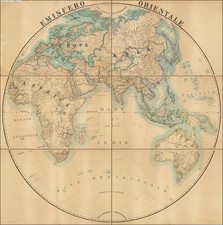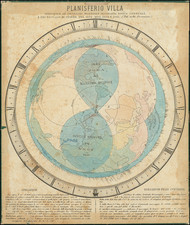Striking World Map from a Miniature Atlas
Fine world map from Petrus Bertius’ miniature atlas, framed by decorative strapwork details. It bears a Latin inscription that translates to, “the Earth and the fullness of it is the Lord’s.”
The world is shown on an oval projection. Africa has both the Nile and the Gambia Rivers. Asia includes Goa, where the Portuguese had a trading colony, and the islands of Southeast Asia, where the Dutch and English East India Companies were both in operation. Japan is depicted as a single, rectangular island.
The Moluccas, or the Spice Islands, are tucked near the eastern edge of the projection. Nearby, a larger coastline extends into the frame and emerges from the western edge as well. This is New Guinea, which is not connected to the huge southern continent—Terra Australis nondum cognita, or the South Land not yet discovered—which stretches across the entire southern side of the map.
Terra Australis includes Tierra del Fuego, on the south side of the Straits of Magellan, first encountered by Ferdinand Magellan on his crew’s pioneering circumnavigation of 1519 to 1522. The other toponym on the Southern Continent is Psittacorum Regio. This name refers to an area supposedly densely populated with parrots. This place name appeared on Mercator’s 1541 globe and his 1569 world map. It was supposed to have been sighted by Portuguese sailors but was never verified in terms of size or location.
South America is criss-crossed by the Amazon and the Rio de la Plata, which are connected here. North America balloons in the north, disappearing toward the North Pole and connecting to Greenland. Several of the toponyms are familiar, like California (here a peninsula), Virginia, and Florida. Less familiar are Anian, with its allusions to a Northwest Passage, and Quivira.
The latter refers to the Seven Cities of Gold sought by the Spanish explorer Francisco Vasquez de Coronado in 1541. In 1539, Coronado wandered over what today is Arizona and New Mexico, eventually heading to what is now Kansas to find the supposedly rich city of Quivira. Although he never found the cities or the gold, the name stuck on maps of southwest North America, wandering from east to west.
This map appeared in Petrus Bertius’ miniature atlas, first published in 1616, and titled, Petri Bertii Tabularum Geographicarum Contractarum Libri septem. . . There was also a double-hemisphere world map in the atlas. The oval-projection map is similar to a world map by Jodocus Hondius the Elder, published in 1598, and itself patterned on a map in Ortelius’ Epitome (1588). Interestingly, Hondius’ signature does not appear on the oval projection while his son’s, Jodocus Hondius the Younger’s, signature is prominently displayed on the double-hemisphere map. The miniature atlas containing this map was issued in 1616 (Latin text), then three times in 1618 (one Latin and two French editions), and once in 1637 (Latin text).
This strait, believed to separate northwestern America from northeastern Asia, was related to the centuries-long quest to find a Northwest Passage connecting the Atlantic Ocean to the Pacific. The rumor of this strait and a Northwest Passage in general inspired many voyages of discovery, including those of John Cabot, Sir Francis Drake, Gaspar Corte-Real, Jacques Cartier, and Sir Humphrey Gilbert.
The term Anian itself comes from Marco Polo’s thirteenth-century accounts of his travels. Polo used the term to refer to the Gulf of Tonkin, but cartographers thought it could refer to this supposed strait between Asia and North America. The Strait of Anian, so named, first appeared in a 1562 map by Giacomo Gastaldi, and was later adopted by Bolognini Zaltieri and Gerard Mercator.
Jodocus Hondius the Elder (1563-1612), or Joost de Hondt, was one of the most prominent geographers and engravers of his time. His work did much to establish Amsterdam as the center of cartographic publishing in the seventeenth century. Born in Wakken but raised in Ghent, the young Jodocus worked as an engraver, instrument maker, and globe maker.
Hondius moved to London in 1584, fleeing religious persecution in Flanders. There, he worked for Richard Hakluyt and Edward Wright, among others. Hondius also engraved the globe gores for Emery Molyneux’s pair of globes in 1592; Wright plotted the coastlines. His engraving and nautical painting skills introduced him to an elite group of geographic knowledge seekers and producers, including the navigators Drake, Thomas Cavendish, and Walter Raleigh, as well as engravers like Theodor De Bry and Augustine Ryther. This network gave Hondius access to manuscript charts and descriptions which he then translated into engraved maps.
In 1593 Hondius returned to Amsterdam, where he lived for the rest of his life. Hondius worked in partnership with Cornelis Claesz, a publisher, and maintained his ties to contacts in Europe and England. For example, from 1605 to 1610, Hondius engraved the plates for John Speed’s Theatre of the Empire of Great Britaine.
One of Hondius’ most successful commercial ventures was the reprinting of Mercator’s atlas. When he acquired the Mercator plates, he added 36 maps, many engraved by him, and released the atlas under Mercator’s name, helping to solidify Mercator’s reputation posthumously. Hondius died in 1612, at only 48 years of age, after which time his son of the same name and another son, Henricus, took over the business, including the reissuing of the Mercator atlas. After 1633, Hondius the Elder’s son-in-law, Johannes Janssonius, was also listed as a co-publisher for the atlas.
Petrus Bertius was a Flemish historian, theologian, geographer, and cartographer. Known in Dutch as Peter de Bert, Bertius was born in Beveren. His father was a Protestant preacher and his family fled to London around 1568. The young Bertius only returned to the Low Countries in 1577, to attend the University of Leiden. A bright pupil, Bertius worked as a tutor and was named subregent of the Leiden Statencollege in 1593. He ascended to the position of regent in 1606, upon the death of the former regent, who was also Bertius’ father-in-law. However, due to his radical religious views, he eventually lost his teaching position and was forbidden from offering private lessons.
His brothers-in-law were Jodocus Hondius and Pieter van den Keere, who were both prominent cartographers. Bertius began his own cartographic publishing in 1600 when he released a Latin edition of Barent Langenes’ miniature atlas Caert Thresoor (1598). He published another miniature atlas that first appeared in 1616.
By 1618, Bertius was named cosmographer to Louis XIII. He converted to Catholicism and took up a position as professor of rhetoric at the Collège de Boncourt (University of Paris). In 1622, Louis XIII created a chart of mathematics specifically for Bertius and named him his royal historian. He died in Paris in 1629.









![(Second World War) Newsmap -- Monday, November 23, 1942 [on verso:] Life Save #2 Winning Friends - Helping People](https://storage.googleapis.com/raremaps/img/small/94937.jpg)
![[ Eastern Hemisphere Globe Gores. ] (Nova et integra universi Orbis descriptio)](https://storage.googleapis.com/raremaps/img/small/54480.jpg)

![Mappe-Monde ou Carte Generale du Globe Terrestre, Representee en deux Plan-Hemispheres [World Map or General Map of the Earth, Represented in Two Plan-Hemispheres]](https://storage.googleapis.com/raremaps/img/small/93262.jpg)
![[World] Generale Ptholemei](https://storage.googleapis.com/raremaps/img/small/94338.jpg)
